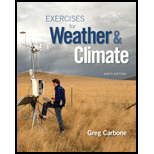
At 5° N latitude there are two peaks of incident solar radiation (that is, solar radiation striking Earth’s surface) during the year. Why does this location differ from other latitudes that have only one peak?
The reason why the
Answer to Problem 1E
Every latitude to the north of
Explanation of Solution
The region of the Earth receiving direct insolation from the Sun fluctuates seasonally during a year owing to the axial tilt, rotation, and revolution of the Earth. The daylight hours will be more in the region that is inclined more toward the Sun.
On June 21st, the day of June Solstice or Summer Solstice, the Sun will be directly above the Tropic of Cancer (
On December 22nd, the day of December Solstice or Winter Solstice, the Sun will be directly above the Tropic of Capricorn (
Unlike these latitudes, the Sun would be above the
Want to see more full solutions like this?
Chapter 4 Solutions
Exercises for Weather & Climate (9th Edition)
Additional Science Textbook Solutions
Physics for Scientists and Engineers: A Strategic Approach, Vol. 1 (Chs 1-21) (4th Edition)
Human Biology: Concepts and Current Issues (8th Edition)
Chemistry: The Central Science (14th Edition)
College Physics: A Strategic Approach (3rd Edition)
Applications and Investigations in Earth Science (9th Edition)
Chemistry: An Introduction to General, Organic, and Biological Chemistry (13th Edition)
- 47) Deflation is the process by which A) wind transports smaller particles leaving behind only larger pebbles and rocks. B) sands are deposited closer to the source area and silts are deposited farther. C) sand dunes migrate downwind as sand saltates up the windward face. D) rocks are worn away by bombardment of particles carried in Windstream.arrow_forward46) In Barchan dunes, the slip face is oriented A) on the convex side of the dunes. B) parallel to wind direction. C) on the concave side of the dunes. D) at varying angles.arrow_forward43) Glacial abrasion is when A) boulders are fragmented into smaller particles under the weight of the overlying ice. B) blocks of rocks are plucked from the underlying bedrock. C) rocks are carried at the base of a glacier and grind away at the underlying bedrock. D) debris fall onto the top of the glacier and are carried down glacier.arrow_forward
- 34) Which of the following is true of soils? A) Soils rich in mineral matter are usually dark in colour. B) They usually require hours or days to form. C) Their development is affected by climate and organisms. D) Their properties are not affected by the type of rock from which they form. E) Older soils usually have fewer horizons than younger soils.arrow_forward44) In periglacial environments, the layer of ground that thaws every summer and freezes every winter is called A) frost layer B) permafrost C) active layer D) discontinuous permafrostarrow_forward42) The ablation zone of a glacier A) has a total positive mass balance. B) is where snow accumulates and transforms into ice. C) is located in the upper part of the glacier. D) is where ice mass is lost.arrow_forward
- 41) Alpine glaciers A) are the largest types of glaciers. B) conform to the shape of the landscape. C) cover large sections of continents. D) show no relationship with the underlying topography.arrow_forward40) Marine terraces are the result of A) coastal emergence through uplift or sea level decrease. B) coastal submergence through erosion or sea level increase. C) deposition of sands by the longshore current. D) wave refraction causing a loss of energy that allow sediments to be deposited.arrow_forward39) Translatory waves A) are the types of waves located furthest away from the shore. B) are slowed down by friction with the bottom of the ocean. C) move water particles in perfectly circular orbits. D) do not interact with the bottom of the ocean.arrow_forward
- 37) Which of the following terms is used for a type of sediment transport in streams? A) discharge. B) overland flow. C) saltation. D) sheet flow. E) abrasion.arrow_forward33) You would expect only slight physical and chemical weathering under conditions of A) temperatures below freezing. B) extreme cold and high precipitation. C) extreme heat and no precipitation. D) lower mean annual rainfall and temperatures. E) higher temperatures and lower precipitation.arrow_forward36) Soil moisture that plants are capable of accessing and using is called A) hygroscopic water. B) wilting point water. C) gravitational water. D) free molecular water. E) capillary water.arrow_forward
 Applications and Investigations in Earth Science ...Earth ScienceISBN:9780134746241Author:Edward J. Tarbuck, Frederick K. Lutgens, Dennis G. TasaPublisher:PEARSON
Applications and Investigations in Earth Science ...Earth ScienceISBN:9780134746241Author:Edward J. Tarbuck, Frederick K. Lutgens, Dennis G. TasaPublisher:PEARSON Exercises for Weather & Climate (9th Edition)Earth ScienceISBN:9780134041360Author:Greg CarbonePublisher:PEARSON
Exercises for Weather & Climate (9th Edition)Earth ScienceISBN:9780134041360Author:Greg CarbonePublisher:PEARSON Environmental ScienceEarth ScienceISBN:9781260153125Author:William P Cunningham Prof., Mary Ann Cunningham ProfessorPublisher:McGraw-Hill Education
Environmental ScienceEarth ScienceISBN:9781260153125Author:William P Cunningham Prof., Mary Ann Cunningham ProfessorPublisher:McGraw-Hill Education Earth Science (15th Edition)Earth ScienceISBN:9780134543536Author:Edward J. Tarbuck, Frederick K. Lutgens, Dennis G. TasaPublisher:PEARSON
Earth Science (15th Edition)Earth ScienceISBN:9780134543536Author:Edward J. Tarbuck, Frederick K. Lutgens, Dennis G. TasaPublisher:PEARSON Environmental Science (MindTap Course List)Earth ScienceISBN:9781337569613Author:G. Tyler Miller, Scott SpoolmanPublisher:Cengage Learning
Environmental Science (MindTap Course List)Earth ScienceISBN:9781337569613Author:G. Tyler Miller, Scott SpoolmanPublisher:Cengage Learning Physical GeologyEarth ScienceISBN:9781259916823Author:Plummer, Charles C., CARLSON, Diane H., Hammersley, LisaPublisher:Mcgraw-hill Education,
Physical GeologyEarth ScienceISBN:9781259916823Author:Plummer, Charles C., CARLSON, Diane H., Hammersley, LisaPublisher:Mcgraw-hill Education,





